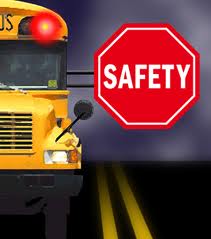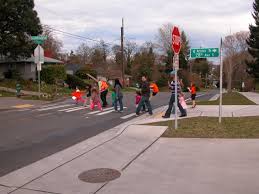
As summer winds down and the school year starts, it is time to remind parents and students about back-to-school safety.
Backpack Safety
- Choose a backpack with wide, padded shoulder straps and a padded back.
- Pack light. Organize the backpack to use all of its compartments. Pack heavier items closest to the center of the back. The backpack should never weigh more than 10 to 20 percent of your child’s body weight.
- Always use both shoulder straps. Slinging a backpack over one shoulder can strain muscles.
- If your school allows, consider a rolling backpack. This type of backpack may be a good choice for students who must tote a heavy load. Remember that rolling backpacks still must be carried up stairs, and they may be difficult to roll in snow.
- Backpack Safety from National Safety Council
Playground Safety
- Check the the playground equipment at your child's school. Look for hazards such as rusted or broken equipment and dangerous surfaces. The surface around the equipment should be covered with wood chips, mulch, sand, pea gravel, or mats made of safety-tested rubber or fiber material to prevent head injury when a child falls.
- Avoid any drawstrings on the hood or around the neck of jackets and sweatshirts. Drawstrings at the waist or bottom of the jacket should extend no more than three inches long to prevent catching in car and school bus doors or getting caught on playground equipment.
- Teach children proper playground behavior: no pushing, shoving, or crowding.
- Give your child strategies for coping with bullies.
- Empower your child. Children are often reluctant to tell adults about bullying because they are ashamed, embarrassed or fearful of retaliation, so it is important to praise them for being brave enough to speak up. Practice with your child what he or she can say if being bullied or how to report a situation to a bus driver or teacher.
- Ask questions. By asking questions, you can find out who was involved, what occurred and where and when it happened. Comforting the child and offering support by nodding and verbally encouraging him or her to go on will help to fully understand the situation.
- Assess the situation. Is the bullying still happening? Has the bullying extended into the classroom, bus, lunchroom, etc.? Do they fear what will happen if they report the bullying? Talk with the child about what he or she needs to feel and be safe. Explore possible actions your child may take to be safer such as eating lunch with another child.
- Inform your child’s school. Your child should never be fearful of another child or going to school, so you need to take the proper actions to prevent any further harm. Work with the school authorities or your child’s teacher to address the bullying. School authorities need to know about the problem to properly address it and create a solution. You also may want to consult with a counselor on how to move forward with your child.
Traveling to and From School
School Bus

- When waiting for a bus, stay at least five giant steps (10 feet/3 meters) from the curb until the bus has completely stopped.
- Check to see that no other traffic is coming before crossing the street.
- Make sure you walk where you can see the bus driver (which means the driver will be able to see you, too).
- Never walk behind the bus.
- Children should always board and exit the bus at locations that provide safe access to the bus or to the school building.
- When the driver signals, walk across the road keeping an eye out for sudden traffic changes.
- Stay in your seat when riding on a bus and hold on to bus handrails when getting on and off a bus.
- Never put your head, arms or hands out of the window.
- 16 Safety Tips for a Safer Bus Ride from First Student.
Car
- Always buckle-up when riding in the car; children 13 and under should ride in the back seat.
- Never share a seat belt.
- Your child should ride in a car safety seat with a harness as long as possible and then ride in a belt-positioning booster seat. Your child is ready for a booster seat when she has reached the top weight or height allowed for her seat, her shoulders are above the top harness slots, or her ears have reached the top of the seat.
- Remember that many crashes occur while novice teen drivers are going to and from school. You should require seat belt use, limit the number of teen passengers, and do not allow eating, drinking, cell phone conversations, texting or other mobile device use to prevent driver distraction. Limit nighttime driving and driving in inclement weather. Familiarize yourself with your state’s graduated driver’s license law and consider the use of a parent-teen driver agreement to facilitate the early driving learning process. For a sample parent-teen driver agreement, see www.healthychildren.org/teendriver
- School Zone Safety

- When a school bus or children are present slow down and proceed with caution, obeying all traffic laws and speed limits.
- Always stop for a school bus that has stopped to load or unload passengers. Red flashing lights and an extended stop arm tell you the school bus is stopped to load or unload children. Under certain conditions State Law requires you to stop.
- If you are on a two-lane roadway, you must stop.
- If you are on a roadway that has two or more travel lanes traveling in each direction and you are traveling the same direction as the bus, you must stop.
- If you are on a roadway that has at least two or more travel lanes traveling in each direction and you are approaching, meeting the bus, you do not have to stop, merely proceed with caution.
- Be alert and ready to stop. Watch for children walking in the street, especially where there are no sidewalks. Watch for children playing and gathering near bus stops. Watch for children arriving late for the bus, who may dart into the street without looking for traffic. When backing out of a driveway or leaving a garage, watch for children walking or biking to school.
- When driving in neighborhoods or school zones, watch for young people who may be in a hurry to get to school and may not be thinking about getting there safely
Bike
- Wear a helmet every time you ride your bicycle and make sure the helmet fits correctly.
- Ride on the right, in the same direction as auto traffic.
- Use appropriate hand signals.
- Always walk your bicycle when you need to cross a street.
- Wear bright-colored clothing to increase visibility. White or light-colored clothing is especially important after dark.
- Know the "rules of the road".
Walking

- Use crosswalks for crossing streets and remember to look left, right, left before crossing. (Children under 10 should cross with the assistance of a grown-up.)
- Make sure your child's walk to school is a safe route with well-trained adult crossing guards at every intersection.
- Be realistic about your child's pedestrian skills. Because small children are impulsive and less cautious around traffic, carefully consider whether or not your child is ready to walk to school without adult supervision.
- If your children are young or are walking to a new school, walk with them the first week or until you are sure they know the route and can do it safely.
- Bright-colored clothing will make your child more visible to drivers.
- In neighborhoods with higher levels of traffic, consider organizing a “walking school bus,” in which an adult accompanies a group of neighborhood children walking to school.
Other Resources:
- Sparky the Fire Dog's Back-To-School Safety.
- American Academy of Pediatrics
- First Student Media Kit
- Back-to-School Fire Safety
Sources: American Academy of Pediatrics (www.aap.org), National Fire Protection Agency (www.nfpa.org), National Safety Council (www.nsc.org), and First Student (www.firststudent.com)
